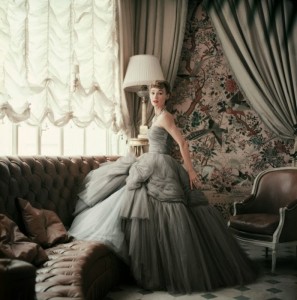
Welcome to our new series about venerable design houses and the changes brought by new designers. This is the brainchild of the wonderful Shannen Lindsey, one of our students.
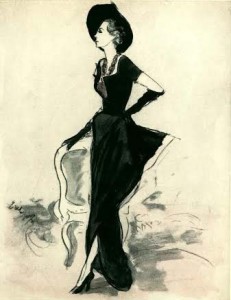
The big couture houses, we hope, will survive profitably for far longer than the lifespan of their original designers. This series will take a look at the new designers hired by several couture houses. This spot will be published at the beginning of the next few months, here on Volumes & Issues.
Christian Dior, founder, 1946-1957
Christian Dior came of age in the artistic cauldron of Paris between WWI and WWII. His creative development began when he opened an art gallery. Despite (or possibly because of) showing such artists as Salvator Dali, Pablo Picasso, Raoul Dufy and Georges Braque, the gallery failed. In 1935, after a bout of tuberculosis, Dior found himself in Paris and broke. He took up fashion drawing, inspired by established designers Molyneux, Chanel, Schiaparelli, and Lanvin. By 1938, his abilities had grown enough that Robert Piguet offered him a position as designer in his couture studio.
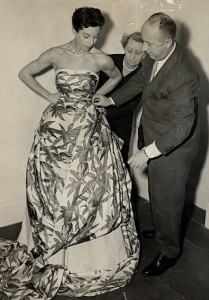
After WWII, Dior returned to Paris, where he worked for Lucien Lelong alongside Pierre Balmain. By 1946, Dior had put together financial backing. He opened his own couture house in October. Although grounded in his avant-garde youth, Dior’s fashion vision recalled a romanticized Gilded Age. After wartime shortages, this nostalgic vision of women draped in yards of luxurious cloth was a radical shift in fashion, and was quickly dubbed “The New Look” by the fashion editor of Harper’s Bazaar.
Dior’s lavish designs were a big hit and influenced fashion at all price points for the next decade. He is widely credited for bringing the French couture industry back to life after WWII. He also helped create the designer ready-to-wear industry and the designer boutique, encouraging women to wear his design vision from head to toe.
In 1957, Christian Dior died unexpectedly of a heart attack.
For more details, see these FIT references:
FITDB-Berg Fashion Library: Dior
The Metropolitan Museum of Art also has a terrific collection of Dior’s work.
Yves Saint Laurent, Principal Designer 1957 – 1960
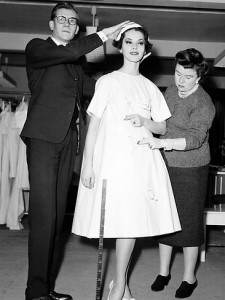
After showing him sketches resembling Dior’s “H” line, Saint Laurent was introduced to Christian Dior by the editor of French Vogue. Dior hired him immediately. After Dior’s sudden death in 1957, St. Laurent became head of the House of Dior at the age of 21. His initial collections were well received, but his Beat Collection of 1960, was a step too modern for the traditional Dior customer.
He was drafted into the army in the fall, and swiftly replaced as designer by Marc Bohan. In 1961 he opened his own fashion house, and went on to make his mark under his own name.
For more details on YSL, check out these resources:
FITDB-Oxford Art Online: St. Laurent
FITDB-Berg Fashion Library: St. Laurent
Marc Bohan, Principal Designer 1960-1989
Bohan entered the rarified French fashion industry in 1945 with a job at Piguet. He spent a few years after that working at Molyneux, then joined Patou in 1950. Dior recruited him from there to run the London branch of the house of Dior. When St. Laurent proved to be a bad fit for the Dior customer, Bohan was appointed new head of the Paris workrooms.

Bohan continued to design for Dior for another 29 years. The designer was known for his passion for detail and fit, and his skillful use of rich materials. Under his leadership, the House of Dior produced well-made clothes that maintained the sobriety desired by the Dior client, but with a dash of fresh trends to keep them current. Notices of his runway shows throughout the 1960s refer to him as “provacative” and “flirty”, but still sophisticated.

By the late 1980s, however, his work had grown conservative enough that Karl Lagerfeld described the House of Dior’s image as “a gray suit with lilies of the valley in the pocket”. (WWD, 1989: May 11: 2) Despite WWD’s raves about his spring 1988 collection (WWD, 1988, Jan 26: 1), Dior management unceremoniously replaced him with Gianfranco Ferre’ in 1989.
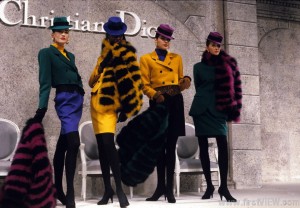
Fall 1988
Bohan’s work was beloved by several notable fashion icons. Princess Grace of Monaco, Betsy Bloomingdale, and Lynn Wyatt were some of his prominent clients. Jacqueline Kennedy had some of his designs adapted by her American designer, Oleg Cassini.
Several further resources:
http://www.fashionencyclopedia.com/Bo-Ch/Bohan-Marc.html
http://www.catwalkyourself.com/fashion-biographies/marc-bohan/
Gianfranco Ferré, Stylistic Director 1989 – 1997
When Dior hired Gianfranco Ferre’ in 1989, the fashion world was taken aback that a prominent French couture house should choose a non-Frenchman for this prominent position. This move was also seen as a sign that Milan’s fashion houses had gained worldwide recognition.
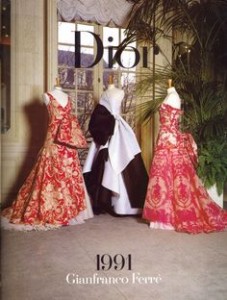
Ferre’ originally trained as an architect, and began his design career by creating jewelry and accessories for Italian design houses. He opened his first design studio in 1974. He continued to design under his own name even after Bernard Arnault recruited him to Dior in 1989.
Ferre’s work was known for crisp geometric cuts, clean shapes, elaborately constructed ballgowns, and sharply tailored suits. This detailing earned him the nickname “the architect of fashion”.
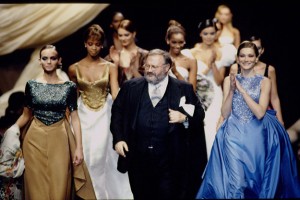
His first few collections for Dior had trouble blending this hard-edged style with the softer romanticism Dior was known for, but Ferre’ developed the style, keeping his own line both more linear and more casual than his work for Dior.

Like Dior, St. Laurent, and Bohan before him, Ferre’ had a devoted client base which included Sophia Loren, Elizabeth Taylor, Sharon Stone, and Diana, Princess of Wales.
Once the House of Dior moved on to John Galliano, Ferre’ was free to concentrate solely on his designs under his own name. He died in 2007, shortly before showing his Spring 2007 menswear collection.
John Galliano, Creative Director 1997 – 2011
Galliano established his own design house while still a student. His collections were known for their impeccable attention to detail and his playful reimagining of fashion’s history. In 1995, he was hired by Moet Henessy Louis Vuitton (LVMH) director Bernard Arnault to revitalize the couture house of Givenchy, and then in 1996, Arnault appointed Galliano Creative Director at the House of Dior, surprising the fashion press and Galliano himself.
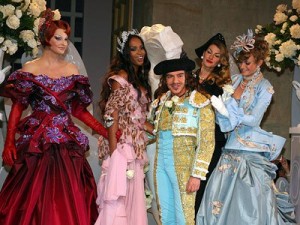
Galliano tapped Dior’s own love for the Belle Epoch while deconstructing the elements and reconstructing them in elaborate and sometimes odd juxtapositions. Galliano recreated both himself and the couture brand for each show, referring to influences as diverse as the Spanish Toreador, Rag Balls of the 1930s, the Masai tribe, and Dior’s original new look.
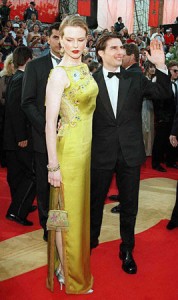
Embracing the current of street fashion and the rise of the luxury accessory, Galliano developed the House of Dior into a 21st-century brand: romantic, exclusive, and chic, but still multi-referential. Some of his famous clients included Beatrice de Rothschild, Nicole Kidman, and Cate Blanchett.
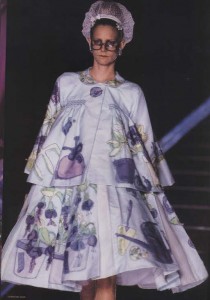
In February of 2011, film of Galliano in Paris making anti-Semitic comments to pedestrians surfaced, inducing LVMH to fire Galliano (from both Dior and his own line) and the victims of his rant to sue him for public insult. He was convicted of these, paying the subsequent fines. Speculation in the fashion press remained that LVMH had allowed Galliano such leeway because his outrageous personality contributed to the cachet he brought the Dior brand. (WWD & NYT spring 2011)
For more information:
FITDB-Berg Fashion Library: Galliano
Bill Gaytten, Artistic Director 2011 – 2012
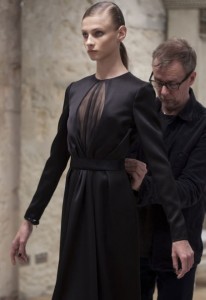
When Galliano was disgraced, LVMH dismissed him from both his design enterprises: his directorships at Christian Dior and his own namesake, John Galliano. Bill Gaytten, a self-taught designer, had worked closely with Galliano since 1994, and was the obvious choice to replace him.
Like Ferre’ before him, Gaytten had begun his training as an architect. Fascinated with fashion, he taught himself draping and patternmaking. Through a friend at Central Saint Martin’s, he was introduced to John Galliano.
Beginning in 1994 as a cutter with the company, he grew into a position in Galliano’s design studio, and was involved in both Givenchy and Galliano projects. When Galliano was tapped for Dior, Gaytten accompanied him.
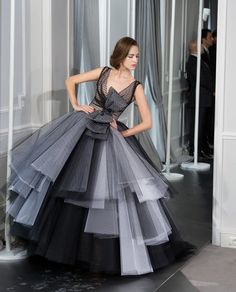
Gaytten brought his own vision to the Dior line, one that he admitted was less romantic than Galliano’s, but perhaps more sleekly modern. (WWD, Sept 29 2011: 7) Reflecting his architectural background, his couture collection for Dior spring 2012 used sheer fabrics to show off detailed interior construction work, saying, “it’s such amazing work…No one sees it. We see it, but the clients should see it.” (WWD, Jan 24 2012: 2)
Despite critical acclaim, Gaytton was continuously “faced with the challenge of creating collections while largely being considered an interim designer…his often pretty clothes… lacked the excitement to propel the brand forward.” (WWD, Apr 10: 5). By the time Gaytton produced his last show, the news that LVMH had replaced him with Raf Simons had already been announced.
For more details:
Raf Simons, Artistic Director 2012 – 2016
Perhaps Bill Gaytton’s modernistic vision opened LVMH to a sleeker Dior, because their next choice for Artistic Director had distinguished himself as a minimalist designer from his first menswear collection in 1995. Raf Simons was hired away from Jil Sander, where he had worked since 2006, after the departure of the founding designer.

Simons, known for his surgically-minimalist menswear, exploration of proportions and volume, as well as his incisive tailoring, was an unusual choice for what is, arguably, the most romantic of the French couture houses. Trained as an industrial designer, Simons represents the next wave of forward-thinking fashion designers working in Belgium, beginning with a street-inspired collection of menswear in 1995.
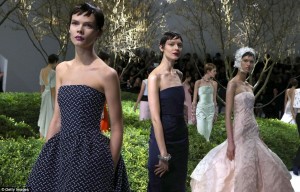
Dior’s interest perhaps grew from Simons’ spring 2011 and 2012 collections for Jil Sander, which riffed off the grandeur of couture and the Victorian excesses of Worth and Winterhalter. Critically acclaimed, the 2012 collection “reimagined ideas from from the Fifties [sic]into hyperchic fashions for today”. (WWD, Dec 13 2011:2)
For more details, read up in WWD:
Even more ironic than the second-largest French couture house hiring a Belgian-born designer known for his minimalism, is that just after I began this post, Simons announced that he would retire from Dior and refocus on his own signature lines.
Who will be next?
The library has many resources that could help you find out more about these people and their work. Here are just a few:
http://wwd.com/fashion-news/designer-luxury/raf-simons-exit-dior-10267081/
http://www.vogue.com/13365275/dior-finding-raf-simons-successor/
The Official House of Dior has a more detailed history of the company here:
The library has files on Christian Dior , Marc Bohan (under House of Dior), Gianfranco Ferre’, and John Galliano scanned and available in FITDIL. Browse under “FIT Library Designer Files”.
Bibliographic articles:
FITDB-Berg Fashion Library: Dior
Selected Books in our holdings (use “Dior” as a search term):
Elizabeth Uss, “John Galliano,” 5th fl. Circulation Desk TT502.G23 2008
Charlotte Sinclair, “Vogue on Christian Dior,” 5th fl. Main Stacks TT505.D5 S56 2014
Farid Chenoune, “Dior,” 5th fl. Main Stacks TT505.D5 C54 2007
Caroline Bongrand, “Dior,” 5th fl. Main Stacks TT505.D5 B65 2012
and many, many more!
Comments
3 responses to “Dior: From New Look to New Talent”
The first photo, gray chiffon from 1953, is just gorgeous!
I know, right? Want. That’s why I posted that one 😀
[…] 1941, Lelong hired Balmain as co-principle designer beside Christian Dior. The two worked together well, each helping the other’s work improve. Like Dior, […]